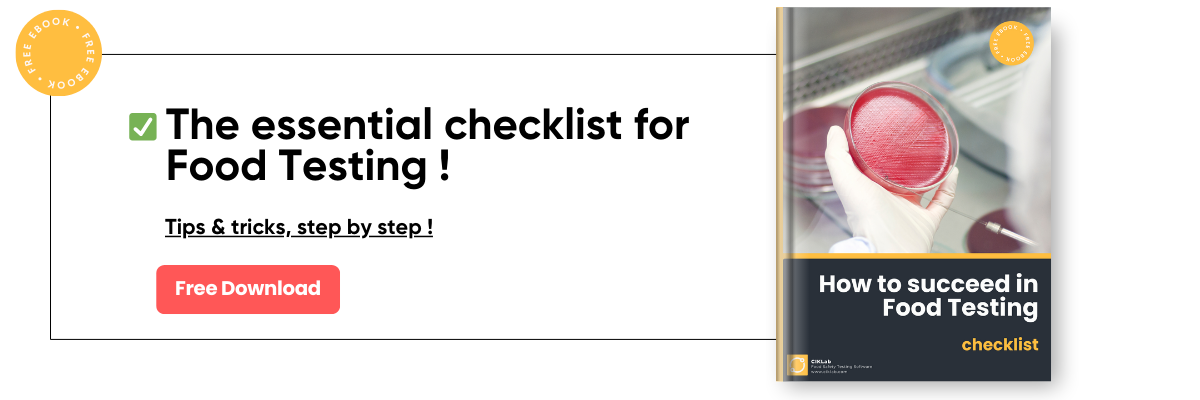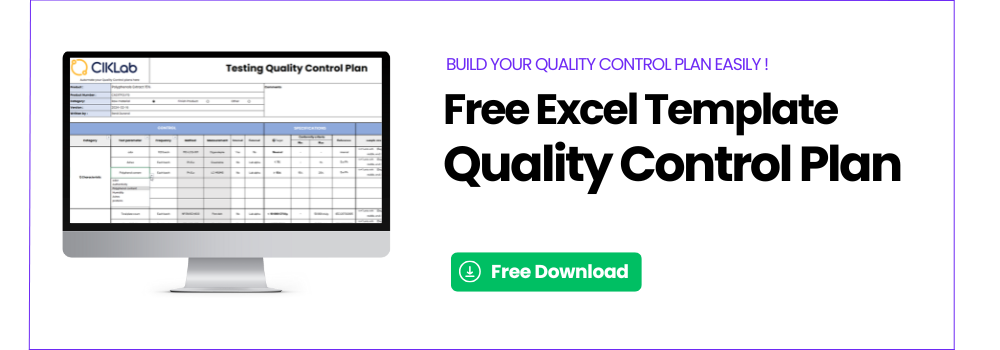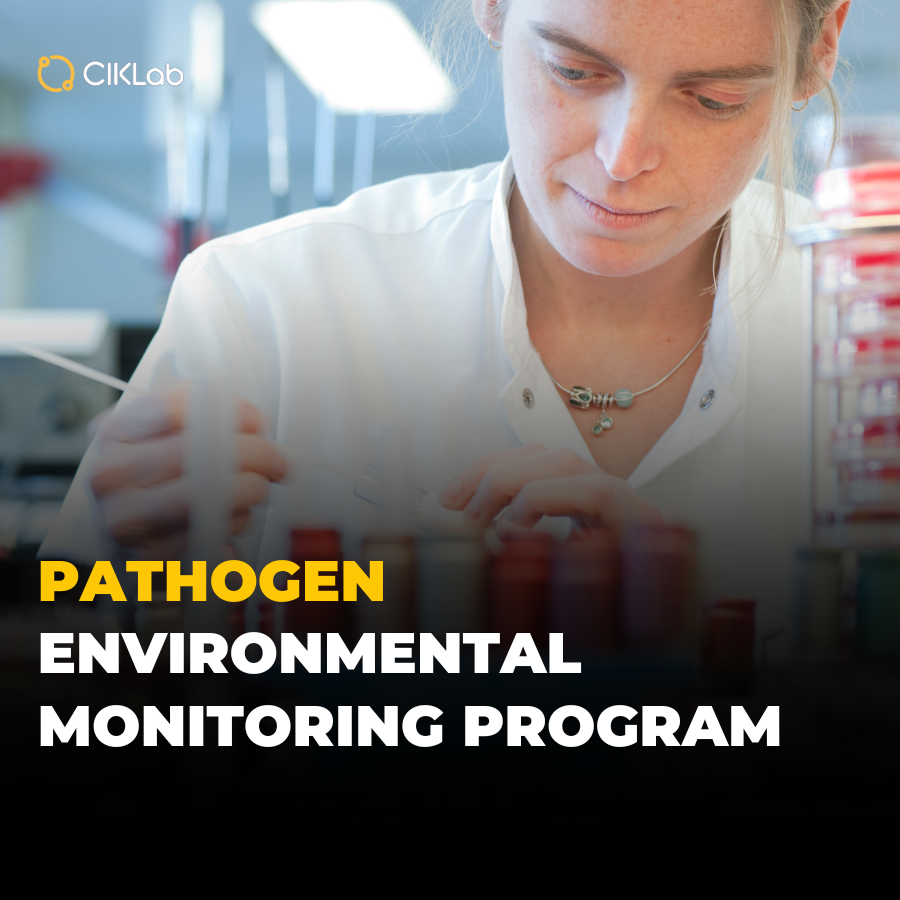To guarantee food safety, it is essential to carry out control analyses throughout the manufacturing process. These analyses make it possible to detect contaminants and certain pathogens, assess nutritional composition and check compliance with regulatory standards.

Summary :
1) Why are quality control analyses essential in the food industry ?
2) What analyses should be performed ?
3) What are the inspection intervals ?
3) How to take advantage of Quality Control
4) How can software help you enhance the value of your control analyses ?
An estimated 600 million – almost 1 in 10 people in the world – fall ill after eating contaminated food and 420 000 die every year, resulting in the loss of 33 million healthy life years
(WHO)
Why are quality control analyses essential in food industry?
First and foremost: it's a regulatory obligation
Food safety is a regulatory requirement for all food businesses. In Europe, the Hygiene Package, which came into force in 2006, encompasses the regulations applicable to food industry professionals. This set of texts, including regulation EC 178/200, places responsibility for food safety on the professionals who place products on the market.
Although it does not impose an obligation of means, it does require an obligation of result.
(30) A food business operator is best placed to devise a safe system
for supplying food and ensuring that the food it supplies is safe;
thus, it should have primary legal responsibility for ensuring food
safety.EC 178/2002
It is therefore up to manufacturers to put in place a set of rules, procedures and verification systems to ensure product safety.
Quality management or quality assurance systems help to create an environment in which manufacturing can be controlled. These systems, which use a process approach, are based on risk assessment, in particular using the HACCP method to draw up flow diagrams and sanitary control plans. These control plans list all hazards : microbiological, chemical, foreign bodies, allergens, etc. The certification covering food safety management is the FSSC 22000 standard.
Once the hazards and risks have been identified, the effectiveness of the control measures must be assessed, and this is where quality control comes in.
The main objective of food quality control is to check the safety of the finished products placed on the market, which of course, as we have just seen, is the mantra of quality control.
- To comply with various regulations and specifications.
- Increase knowledge of products and manufacturing processes.
- Strengthen our ability to detect non-conformities as far upstream as possible.
- Continuously improve the control system
- Reduce the costs associated with non-quality
- Generate ever greater confidence in your control system, and consequently in your company, its products and its brand image.
Before defining the control analyses, you need to know what you are trying to verify and start by drawing on all the regulations applicable to your sector, from the most general to the most specific (such as the type of product, for example). The list is long, but it is absolutely essential to know and clearly list all the regulations governing your activity.
This overview will give you the minimum required. By combining this regulatory section with your risk analysis (product, process, etc. 5M), you will be able to plan your checks and define your specifications.
The essentials :
- Define your regulatory environment
- Have a list of reliable and qualified suppliers
- List the specifications for each incoming raw material (know the regulatory framework for the raw material, e.g. a plant, an additive, a processing aid, packaging, etc.).
- Describe all stages of the process (and the manufacturing environment) to identify hazards and risks and define CCPs
- Know, describe and document all formulas.
- Define all finished product specifications.
All these steps will enable you to list all the analyses and controls to be carried out on your raw materials, your products and your finished products.
What analyses should be performed on food products?
Few industries need so many different analyses and skills!
Authenticity testing
Are you sure of what you're buying?
Authenticity is a huge issue in the food industry, and analyses play a crucial role for your business. They are essential for ensuring product safety and protecting consumers, but also for combating fraud. These analyses enable us to detect problems such as plant mix-ups, medicinal substances (products of animal origin or food supplements), geographical origins (PDO/PGI), deliberate adulteration motivated by financial gain, such as the wetting of milk, mixtures of edible oils, animal species (horse vs. beef), GMOs, and even drug trafficking! (flour)
Some analysis techniques used in authenticity checks:
- PCR (polymerase chain reaction) : this technique can be used to detect the presence of DNA from specific species, but it may be useless on certain products where the DNA can no longer be extracted.
- Chromatographic methods are the most frequently used: they enable the components of a mixture to be separated and identified for comparison with profiles of target molecules or banks of known and authenticated samples.
- HPLC/UPLC (High-Performance Liquid Chromatography)
- GC (Gas Chromatography)
- HPTLC / CCM (High-Performance Thin-Layer Chromatography)
- SFC (Supercritical fluid chromatography)
- NMR (Nuclear Magnetic Resonance) is used to measure isotopic ratios such as the 13C/12C ratio and the δ18O (delta-O-18) oxygen ratio. This extremely powerful technique can, for example, determine the type of sugar used in a product (beet vs cane sugar), or the geographical origin of vanilla or honey.
- RAMAN spectroscopy
- FTIR (Fourier Transform Infrared Spectroscopy)
- Sensory studies - yes, taste and olfaction are the oldest analytical techniques.
The type of product will play a very important role in the choice of techniques to be used, and there are many specialist laboratories that can help you select the most appropriate technique for you and the product to be tested.
Nutritionnal facts
Regulation INCO 1169/2011 imposes obligatory labelling in Europe, which must include a certain amount of information, such as: the name of the product, the list of ingredients, the net quantity, the use-by date, storage conditions, instructions for use, allergens, nutritional value, etc.
Nutritional values are determined after analysing the composition of a food product and give the energy value expressed in kilocalories (kcal) or kilojoules (kJ).
- Carbohydrates including sugars, and sugar profile (Fructose, Glucose, Lactose, Maltose, Saccharose) polyols, starch
- Total fat, saturated fatty acids and fatty acid profile including trans fatty acids: Saturated fatty acids, monounsaturated fatty acids, polyunsaturated fatty acids, omega 3, omega 6 and omega 9.
- Protein
- Total dietary fibre
- Minerals and trace elements
- Moisture
- Vitamins
- Salt
These analyses are not performed on every production batch, but must take into account and minimise product variability.
Allergens
The allergens listed below must be declared on labels. The main risk for manufacturers is cross-contamination or accidental presence.
- Cereals containing gluten (wheat, rye, barley, oats, spelt, kamut or their hybridised strains) and products based on these cereals.
- Crustaceans and crustacean-based products
- Eggs and egg-based products
- Fish and fish products
- Peanuts and peanut-based products
- Soya and soya-based products
- Milk and milk-based products (including lactose)
- Nuts (almonds, hazelnuts, walnuts, cashew nuts, pecans, macadamia nuts, Brazil nuts, Queensland nuts, pistachios) and nut products.
- Celery and celery products
- Mustard and mustard-based products
- Sesame seeds and sesame seed products
- Sulphur dioxide and sulphites in concentrations of more than 10 mg/kg or 10 mg/l (expressed as SO2).
- Lupins and lupin-based products
- Molluscs and mollusc-based products
Various techniques can be used to detect or quantify allergens
- Immunological assay such as ELISA (enzyme-linked immunosorbent assay) tests
- PCR (polymerase chain reaction) and qPCR (quantitative PCR) to detect and specifically identify allergen DNA or RNA sequences.
- LC-MS, liquid chromatography coupled with a mass spectrometer
Microbiology
The microbiological risk is the most serious in the food industry, and the consequences of foodborne illnesses can be extremely severe.
The analyses consist of verifying, at a minimum, the absence of pathogens in the finished products, as well as throughout the manufacturing process. Pathogens include not only bacteria but also viruses, yeasts, molds, algae, parasitic protozoa, and microscopic parasitic worms.
The microbiological control plan is associated with the sanitary control plan, which establishes the hazards and risks of raw materials and manufacturing processes, but also relies on good hygiene practices.
The type of product, its use, and the manufacturing process determine the choice of pathogens to be tested, the frequency of controls, and the sampling. In Europe, this is governed by Regulation EC 2073/2005, which sets the criteria applicable to foodstuffs.
There can be multiple methods for the detection and enumeration of bacteria, viruses, and parasites, which may depend on the techniques used and the matrices being analyzed.
Common analyses and standards in the food industry are:
| Germes | Normes |
| Salmonella | NF EN ISO 6579 |
| Escherichia coli (E. coli) | NF EN ISO 16649-2 |
| Listeria monocytogenes | NF EN ISO 11290-1 |
| Staphylococcus aureus | NF EN ISO 6888-1 |
| Clostridium perfringens | NF EN ISO 7937 |
| Campylobacter | NF EN ISO 10272-1 |
| Bacillus cereus | NF EN ISO 7932 |
| Vibrio cholerae | NF EN ISO 21872-1 |
| Yersinia enterocolitica | NF EN ISO 10273 |
| Cronobacter sakazakii | NF EN ISO 22964 |
| Total aerobic mesophilic flora | NF EN ISO 4833 |
| Yeasts & Molds | NF EN ISO 21527-1 |
| Enterobacteriaceae | NF EN ISO 21528-2 |
| Escherichia coli O157:H7 | NF EN ISO 16654 |
| Hépatite A et Norovirus GI / GII | NF EN ISO 15216-2 |
| Cryptosporidium et Giardia | NF EN ISO 18744 |

Microbiological analysis of food
Chemical contaminants
Recent years have seen the emergence of new analysis techniques that are constantly being perfected. They enable us to identify more and more contaminants and to reduce the limits of quantification. Regulations such as EC 2023/915 are regularly updated in line with developments in analytical techniques, EFSA opinions, toxicological data and population exposure.
There are different types of chemical contaminants that can enter the food chain :
Naturally occurring toxins :
- Mycotoxins produced by certain molds such as aflatoxins, patulin, ochratoxin A, deoxynivalenol.
- Alkaloids produced by certain plants: tropane alkaloids (atropine, scopolamine), pyrrolizidine alkaloids, opioid alkaloids, glycoalkaloids (solanine).
- Furocoumarins.
- Cyanogenic glycosides.
- Curcubitacines
- Lectins.
- Marine toxins: phycotoxins, saxitoxin.
Environmental chemical contaminants :
- Heavy metals (lead, cadmium, mercury, arsenic, etc.)
- Dioxins and furans (PCDD/F) PCBs
- Pesticides (insecticides, fungicides, herbicides)
- Hydrocarbons, BTEX
- Drug residues
- Radioactivity (Caesium-137, etc.
Neoformed contaminants
They result from the transformation of foodstuffs:
- Polycyclic aromatic hydrocarbons (PAHs)
- Acrolein
- Chloropropanol esters
- Nitrosamines
- Acrylamide
- Ethyl carbamates
- Glycidol esters
- Chloropropanols (3-MCPD, 1,3-DCP)
- Biogenic amines (AB)
- Hydroxymethylfurfural (HMF)
From food contact materials (packaging, lubricants)
They are often the result of migration between the packaging and the foodstuff.
- Bisphenols
- Phthalates
- PFAS /TOF
- Solvents
- NIAS (Non-Intentionally Added Substances)
Technological and industrial contaminants
- MOSH/MOAH
- PBDEs
- Perchlorates
- PAHs and benzo(a)pyrene
- Solvents
- Cleaning products (benzalkonium)
- etc.
.png?width=1200&length=1200&name=BLOG%20CIKLab%20(3).png)
RMN lab testing
Of course, the list is not exhaustive. There are other contaminants, and it is essential that your risk studies highlight them.
It is vital to have a network of specialised laboratories to deal with each analysis, particularly for contaminants.
How often should I check?
Do you know your process and your control plans by heart? Are the environments, manufacturing processes, and CCPs under control?
Well, consider the main risk as being associated with a poor understanding or assessment of hazards related to raw materials (nature, origin, growing conditions, harvesting, processing, transportation, etc.).
To choose appropriate control frequencies, it is crucial to have a documented risk assessment for each raw material. This will help you to:
- Determine the hazards and their severity.
- Understand the probability of occurrence.
- Assess the risk and criticality.
- Establish compliance thresholds and specifications.
Based on this risk assessment, determine the frequency of control for each analysis:
- Negligible risk and/or justified by a solid study: little or no control.
- Low risk and/or managed: regular interval controls.
- High risk and/or uncontrolled: systematic control.
How can you benefit from Quality Control ?
Transforming a necessity into an advantage!
Ensuring the sanitary control of food products not only protects the consumer, which is the ultimate goal of food quality control, but it offers more :
Cost control : Process control, analysis of raw materials and finished products ultimately reduce costs associated with non-compliance, whether it concerns the products and/or the manufacturing processes. Better control of your products reduces analytical costs by setting appropriate analysis frequencies.
Enhancing your company's brand image : Indeed, the technical, regulatory, and analytical knowledge of your products provides your company with a competitive advantage. Why not highlight all the analyses conducted on your products to create an additional commercial leverage?
💡 Your clients, authorities, and consumers are increasingly seeking transparency and evidence !
How can software help you enhance the value of your control analyses?
Your control software should centralize all data related to food analyses.
An organization initially focused on analysis
💡 A comprehensive and exhaustive list of analyses, methods, and techniques that may be used.
CIKLab allows you to list all the analyses you may need, whether in routine or occasional testing. You can choose the methods, techniques, and units, and categorize them: authenticity, food contaminants, microbiology, etc.
A network of subcontracting laboratories just a click away !
💡 A list of subcontracting laboratories able to carry out these analyses, as well as "back-up" laboratories.
With CIKLab, not only do you have a complete listing of your laboratories, but you can associate all your analyses with potential laboratories and choose the referents and secondaries. There's no need to worry about which lab to send your samples to - it's all automatic!
Simple planning of analyses on products and batches
💡 Plan your analyses with ease : the number of controls can be substantial with varying frequencies and different types of analyses for each product.
CIKLab organizes and secures your analysis scheduling, automatically indicating for each batch :
- Which analyses need to be conducted based on the designated frequencies,
- Which laboratory should perform the analyses,
- What are the expected specifications.
The application allows you to easily order your controls with just a few clicks and track the progress of the analyses at all levels.
Historical data on analysis results for decision-making purposes
💡 Intervene as early as possible by assessing trends and capitalizing on all your results and KPIs
CIKLab enables you to have a constant overview of analysis results across multiple areas of the application. This simplifies periodicity management and allows you to control developments and trends effectively.
💡 These articles might also interest you:
>> How to simplify the process of food safety testing ?
>>Quality Control plans for food industry, what solutions to be efficient?
>> Which natural toxins should be checked for in foods?
©2024 CIKLab.com All rights reserved.








